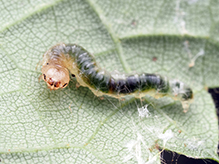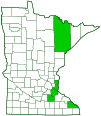sumac leaf blotch miner moth
(Caloptilia rhoifoliella)
Conservation • Description • Habitat • Ecology • Distribution • Taxonomy
|
||||||||
| Hodges # | 0630 |
|||||||
Conservation Status |
||||||||
| IUCN Red List | not listed |
|||||||
| NatureServe | NNR - Unranked SNR - Unranked |
|||||||
| Minnesota | not listed |
|||||||
Description |
||
Sumac leaf blotch miner moth is a micromoth (Microlepidoptera), which is an artificial grouping of moths with a wingspan less than ¾″ (20 mm). It occurs in the United States from Maine to Florida, west to Minnesota and eastern Texas, and in southern Canada from Prince Edward Island west to Manitoba. It is uncommon in eastern Minnesota, where it reaches the western extent of its range. The larvae feed on the leaves of sumacs and poison ivies. Early stage (instar) larvae are leaf miners. Later instars are leaf rollers. In other parts of their range, adults are active from early spring through fall, but in Minnesota the few sightings of adults have all occurred in July or September. Adults are long, slender, and very small, ¼″ to ⅜″ (7 to 9 mm) in length. Males have a 7⁄16″ to ½″ (11 to 13 mm) wingspan. Females are a little smaller, with a ⅜″ to ½″ (10 to 12 mm) wingspan. The upper side of the head is dark brown. The face is white. The sensory mouthparts (labial palps) have three segments, all covered with scales. They are long and turned upward, reaching above the top of the head. The first segment is short. The second segment is long and white, often with some brown scales mixed in. The third segment is long and bright white with a dark brown tip. The antennae are long and blackish brown, and there is a white ring on each segment. They do not have an eye cap at the base. The thorax is dark brown above and on the sides, white below. The abdomen is white. The white areas of the face, thorax, and abdomen have variable amounts of dark brown or black scales mixed in. The forewings are narrow, dark brown or reddish brown, and heavily speckled with darker brown scales. The area near the leading edge (costal margin) is often paler. On some individuals, the area near the costal margin is dark near the base and at the tip. The space between is white with a speckling of dark scales and a row of dark brown dots or blotches. There is a fringe of long, hair-like scales on both the inner and outer margins. The fringe on the inner margin is pale tan, the fringe on the outer margin is dark brown. The hindwings are pale tan with long, pale tan fringes. The legs are long. On the front and middle legs, the third segment (femur) and fourth segment (tibia) are dark brown above. The last part of the legs (tarsus) is white with faint brown marks near each joint. The hind legs are light tan. ________________________________ A detailed description of Caloptilia rhoifoliella could not be found. However, it cannot be distinguished from Caloptilia diversilobiella except by a microscopic examination of the male genitalia. The description above is adapted from the original description of Caloptilia diversilobiella. |
||
Size |
||
Total length: ¼″ to ⅜″ (7 to 9 mm) Wingspan: ⅜″ to ½″ (10 to 13 mm) |
||
Similar Species |
||
Habitat |
||
|
||
Ecology |
||
Season |
||
Two or more generations per year: early spring through fall |
||
Behavior |
||
Adults are active at night and will come to lights. They rest propped up on their forelegs. |
||
Life Cycle |
||
Early stage (instar) larvae are flattened. They feed on sumacs (Rhus spp.) and poison ivies (Toxicodendron spp.). First through fifth instars feed on sap beneath the outer layer of leaf tissue, leaving a narrow linear track (mine). The mine may be on the upper side or underside of the leaf, and it is visible only on that side. It later broadens into a raised (tentiform) blotch that may obscure the initial mine. Later instars are cylindrical and look like typical caterpillars. They feed on leaf tissue. They roll the tip of the leaf downward and tie it with silk, creating an asymmetrical cone in which they feed. Unlike cones of larger leaf rollers, Caloptilia cones do not have visible silken straps on the outside. As the caterpillar feeds, it skeletonizes the cone, consuming the tissue and leaving the veins. It pupates in a silken cocoon within the cone. Pupae overwinter on the ground in fallen leaves. |
||
Larva Food |
||
Sumacs (Rhus spp.) and poison ivies (Toxicodendron spp.) |
||
Adult Food |
||
|
||
Distribution |
||||
|
Sources |
|||
| 12/20/2023 | ||||
Occurrence |
||||
Uncommon in Minnesota |
||||
Taxonomy |
|||
Order |
Lepidoptera (Butterflies and Moths) | ||
Superfamily |
Gracillarioidea (ribbed cocoon-maker and leaf blotch miner moths) | ||
Family |
Gracillariidae (leaf blotch miner moths) | ||
Subfamily |
Gracillariinae | ||
Genus |
Caloptilia | ||
This species was formerly classified as Gracilaria rhoifoliella. A revision of the family Gracillariidae (Vari, 1961) moved it to the genus Caloptilia. |
|||
Synonyms |
|||
Gracilaria rhoifoliella |
|||
Common Names |
|||
sumac leaf blotch miner moth sumac leafblotch miner |
|||
Glossary
Costal margin
The leading edge of the forewing of insects.
Femur
On insects and arachnids, the third, largest, most robust segment of the leg, coming immediately before the tibia. On humans, the thigh bone.
Instar
The developmental stage of arthropods between each molt; in insects, the developmental stage of the larvae or nymph.
Palp
Short for pedipalp. A segmented, finger-like process of an arthropod; one is attached to each maxilla and two are attached to the labium. They function as sense organs in spiders and insects, and as weapons in scorpions. Plural: palpi or palps.
Pupa
The life stage of some insects undergoing transformation. In caterpillars, the chrysalis. Plural: pupae.
Tarsus
On insects, the last two to five subdivisions of the leg, attached to the tibia; the foot. On spiders, the last segment of the leg. Plural: tarsi.
Tibia
The fourth segment of an insect leg, after the femur and before the tarsus (foot). The fifth segment of a spider leg or palp. Plural: tibiae.
Visitor Photos |
|||||
Share your photo of this insect. |
|||||
| This button not working for you? Simply email us at info@MinnesotaSeasons.com. Attach one or more photos and, if you like, a caption. |
|||||
Alfredo Colon |
|||||
 |
|||||
MinnesotaSeasons.com Photos |
|||||
|
|||||

Slideshows |
||

Visitor Videos |
|||
Share your video of this insect. |
|||
| This button not working for you? Simply email us at info@MinnesotaSeasons.com. Attach a video, a YouTube link, or a cloud storage link. |
|||
Other Videos |
|||

Created: 12/20/2023
Last Updated:


